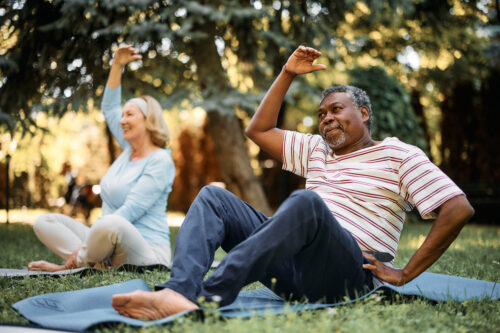
CWP Blog | CWP
Natural Remedies Grow in Popularity: Alternative Approaches to Feeling Better
June 3, 2025
June 3, 2025
CWP
CWP Blog
Yoga, meditation, and other non-traditional wellness approaches have become increasingly popular. In 2022, 15.8% of adults practiced yoga, up from 5% in 2002. Yoga’s popularity has also grown among older adults, with 6.7% of adults aged 65 and older practicing yoga in 2017, up from 2% in 2007. Meditation increased more than threefold from 4.1% in 2012 to 14.2% in 2017. Acupuncture, increasingly covered by insurance, saw growth from 1% in 2002 to 2.2% in 2022.
Thanks to the explosion of digital programs and apps, many non-traditional treatments are now easier to access, making them more readily available to Americans, regardless of gender, race, age or socioeconomic status. As our population ages, there is a growing interest in non-pharmacological therapies that can minimize the adverse effects of aging and promote longevity.
Benefits of Yoga
Yoga offers numerous benefits, as it combines physical postures, breath control, and meditation to enhance physical flexibility, mental clarity, and emotional balance. Among other benefits, it has been found to improve attention, processing speed, executive function, and memory in healthy children and adults. Studies show yoga has a greater impact on enhancing mood and reducing anxiety than other forms of exercise. Why? Because yoga boosts levels of the brain chemical GABA, which helps calm nerves.
Physically speaking, it improves heart health and musculoskeletal strength, as well as guarding against osteoporosis and low bone density. Studies consistently show that the weight-bearing activity of yoga helps slow bone thinning, reducing the risks of osteoporosis, particularly among postmenopausal women.
Diabetes is also on the rise, especially among seniors. Researchers reported that people with diabetes who did yoga three to six days per week for eight weeks shed more pounds and inches than those who walked for the same period.
With age, joints aren’t as fluid as they once were. During your late 50s and early 60s, you may notice that your joints don’t move as smoothly or as comfortably as they once did. Practicing yoga regularly can help lubricate joints, postponing the effects of debilitating disorders such as carpal tunnel syndrome and arthritis. Yin yoga, a type of practice where poses are held for up to 20 minutes, may be especially beneficial for lubricating and nourishing the joints.
Yoga’s slow, measured movements and strengthening poses can additionally help improve balance and prevent falls, which are the leading cause of injury among older adults. Every 11 seconds, an older adult visits the emergency room for treatment related to a fall, according to the Centers for Disease Control and Prevention.
Meditation and Mindfulness Take Center Stage
In recent years, mindfulness and meditation have become buzzwords that are often associated with health and well-being. Meditation is a practice that involves training the mind to achieve a state of mental clarity, focus and inner peace. There are many different forms of meditation. Find the one that’s best for you.
Meditation can offer multiple benefits to your wellness and mood. Benefits of meditation include stress reduction, improved emotional well-being, better sleep, reduced blood pressure and improved heart health, enhanced cognitive function, a stronger immune system, higher levels of energy, and a better chance of managing chronic pain.
Mindfulness is described as a practice that involves paying attention to the present moment with non-judgmental awareness and focusing on your own thoughts. It can be easily incorporated into a meditation routine.
Breathing exercises can help, too
Disease, stress, anxiety, or a combination of those, can cause feelings of breathlessness. Various breathing techniques may help relieve feeling breathless, including deep or pursed-lip breathing, as well as changing seating position. These are all easy techniques that can be practiced at home, at work or even in a public place.
With deep breathing, you take deep breaths through your nose that can be felt down into your abdomen. Lay down when doing this for best results. Focus on filling your lungs with air. Hold your breath for several seconds. Then breathe out slowly through your mouth, emptying your lungs fully.
Another less well-known breathing exercise is pursed-lip breathing. This approach is especially good if shortness of breath is due to anxiety, as it aims to slow down the pace of your breathing. Again, it can be easily accomplished at home or nearly anywhere. Start by sitting upright in a chair with your shoulders relaxed. Press your lips together, being sure to keep a small gap between them. Inhale through your nose for a few seconds and then gently exhale through the pursed lips for a count of four. Repeat as many times as needed until you feel that your breath has become more controlled and less erratic.
Just getting outside can do wonders
Many of us are in front of a screen for much of our day — whether it’s a computer, TV, or phone screen. However, studies have shown that our minds and bodies relax better if we can get into a more natural setting. Being in nature has a positive effect on our bodies by reducing cortisol levels, muscle tension, heart rate and blood pressure. Fresh air can also help increase vitamin D levels, which is important for bones, blood cells and your immune system.
Regular access to green spaces has been linked to lower risks of depression and improved concentration and attention. Additionally, you may find that you sleep better when you are regularly outside because daily exposure to natural light helps regulate sleep and wake cycles.
With various diseases and mobility challenges that come with age, it may seem like getting outside is harder than ever. But it doesn’t need to be. Even five minutes outside feeling the sun on your face can make a difference.
Take a walk if you’re physically able. Even if you can’t, just read quietly, talk on the phone or eat your lunch outdoors to improve your mental outlook, boost your energy level and help your body move better.
Alternative wellness practices like yoga, meditation, breathing exercises and getting outside, are simple yet impactful ways to work more healthy activity into your routine. Nuclear weapons and uranium workers who use their Energy Employees Occupational Illness Compensation Program (EEOICP) benefits can ask their care team about accessible wellness practices for their situations. Cold War Patriots members who are also Professional Case Management clients maximize their EEOICP benefits with care teams who help maintain their independent lifestyles. To check your EEOICP qualifications or to get help with an EEOICP benefits claim, call Cold War Patriots today at 855-230-1339 or email us at [email protected].
